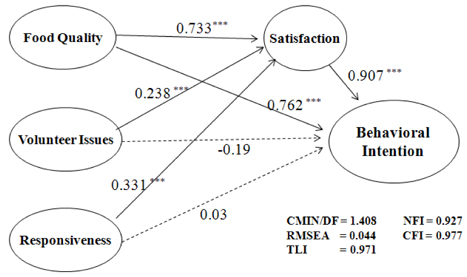Nutr Res Pract.
2011 Apr;5(2):163-168.
Service quality, satisfaction, and behavioral intention in home delivered meals program
- Affiliations
-
- 1Department of Nutrition, Hospitality, and Retailing, Texas Tech University, 2500 Broadway, Lubbock, TX 79409, USA.
- 2Department of Foodservice Management, Kyungsung University, 309, Suyeong-ro, Nam-gu, Busan 608-736, Korea. foodservice@ks.ac.kr
Abstract
- This study was conducted to evaluate recipients' perception of service quality, satisfaction, and behavioral intention in home delivered meals program in the US. Out of 398 questionnaires, 265 (66.6%) were collected, and 209 questionnaires (52.5%) were used for the statistical analysis. A Confirmatory Factor Analysis (CFA) with a maximum likelihood was first conducted to estimate the measurement model by verifying the underlying structure of constructs. The level of internal consistency in each construct was acceptable, with Cronbach's alpha estimates ranging from 0.7 to 0.94. All of the composite reliabilities of the constructs were over the cutoff value of 0.50, ensuring adequate internal consistency of multiple items for each construct. As a second step, a Meals-On-Wheels (MOW) recipient perception model was estimated. The model's fit as indicated by these indexes was satisfactory and path coefficients were analyzed. Two paths between (1) volunteer issues and behavioral intention and (2) responsiveness and behavioral intention were not significant. The path for predicting a positive relationship between food quality and satisfaction was supported. The results show that having high food quality may create recipient satisfaction. The findings suggest that food quality and responsiveness are significant predictors of positive satisfaction. Moreover, satisfied recipients have positive behavioral intention toward MOW programs.
Keyword
Figure
Reference
-
1. US Census Bureau. Projections of the Population by Selected Age Groups and Sex for the United States: 2010 to 2050.2. Weatherspoon LJ, Worthen HD, Handu D. Nutrition risk and associated factors in congregate meal participants in Northern Florida: Role of Elder Care Services (ECS). J Nutr Elder. 2004. 24:37–54.
Article3. Posner BE, Smigelski CG, Krachenfels MM. Dietary characteristics and nutrient intake in an urban homebound population. J Am Diet Assoc. 1987. 87:452–456.
Article4. Millen BE, Ohls JC, Ponza M, McCool AC. The elderly nutrition program: an effective national framework for preventive nutrition interventions. J Am Diet Assoc. 2002. 102:234–240.5. Gollub EA, Weddle DO. Improvements in nutritional intake and quality of life among frail homebound older adults receiving home-delivered breakfast and lunch. J Am Diet Assoc. 2004. 104:1227–1235.
Article6. Locher JL, Burgio KL, Yoels WC, Ritchie CS. The social significance of food and eating in the lives of older recipients of meals on wheels. J Nutr Gerontol Geriatr. 1998. 17:15–33.
Article7. Rosenberg IH. Nutrition and Aging. 1994. New York: McGraw-Hill.8. Silver AJ. Anorexia of Aging and Protein-energy Malnutrition. 1990. New York: Raven Press.9. Coulston AM, Craig L, Voss AC. Meals-on-wheels applicants are a population at risk for poor nutritional status. J Am Diet Assoc. 1996. 96:570–573.
Article10. Carman JM. Consumer perceptions of service quality: an assessment of the SERVQUAL dimensions. J Retail. 1990. 66:33–55.11. Cronin J, Taylor S. SERVPERF versus SERVQUAL: reconciling performance-based and perceptions-minus-expectations measurement of service quality. J Mark. 1994. 58:125–131.
Article12. Parasuraman A, Zeithaml VA, Berry LL. SERVQUAL: A multiple-item scale for measuring consumer perceptions of service quality. J Retail. 1988. 64:12–37.13. Zeithaml VA, Bitner MJ. Services Marketing. 1996. New York: McGraw-Hill.14. Gronroos C. Toward a third phase in service quality research: challenges and future directions. Adv Serv Mark Manag. 1993. 2:49–64.15. Bitner MJ, Hubbert AR. Rust R, Oliver R, editors. Encounter satisfaction versus overall satisfaction versus quality: the customer's voice. Service Quality: New Directions in Theory and Practice. 1994. Thousand Oaks, CA: Sage;72–94.
Article16. Jacobson R, Aaker D. The strategic role of product quality. J Mark. 1987. 51:31–44.
Article17. Spreng RA, MacKenzie SB, Olshavsky RW. A reexamination of the determinants of consumer satisfaction. J Mark. 1996. 60:15–32.
Article18. Stevens P, Knutson B, Patton M. Dineserv: A tool for measuring service quality in restaurants. Cornell Hotel Restaur Adm Q. 1995. 36:56–60.
Article19. Kim HS, Joung HW, Yuan YHE, Wu C, Chen JJ. Examination of the reliability and validity of an instrument for measuring service quality of restaurants. J Foodserv. 2009. 20:280–286.
Article20. Kim HJ, Cahon C, Miller J. Assessing service quality in Korean casual-dining restaurants using DINESERV. J Foodserv Bus Res. 2003. 6:67–86.
Article21. Lirette T, Podovennikoff J, Wismer W, Tondu L, Klatt L. Food preferences and meal satisfaction of Meals on Wheels recipients. Can J Diet Pract Res. 2007. 68:214–217.
Article22. Roy MA, Payette H. Meals-On-Wheels improves energy and nutrient intake in a frail free-living elderly population. J Nutr Health Aging. 2006. 10:554–560.23. Fogler-Levitt E, Lau D, Csima A, Krondl M, Coleman P. Utilization of home-delivered meals by recipients 75 years of age or older. J Am Diet Assoc. 1995. 95:552–557.
Article24. Capra S, Wright O, Sardie M, Bauer J, Askew D. The acute hospital foodservice patient satisfaction questionnaire: The development of a valid and reliable tool to measure patient satisfaction with acute care hospital foodservices. Foodserv Res Int. 2005. 16:1–14.
Article25. Anderson JC, Gerbing DW. Structural equation modeling in practice: a review and recommended two-step approach. Psychol Bull. 1988. 103:411–423.
Article26. Nunnally JC. Psychometric Theory. 1978. New York, NY: McGraw-Hill.27. Hair JF, Anderson RE, Tatham RL, Black W. Multivariate Data Analysis. 1998. Englewood Cliffs, NJ: Prentice Hall.
- Full Text Links
- Actions
-
Cited
- CITED
-
- Close
- Share
- Similar articles
-
- Evaluation of Home-Delivered Meals Service Program for Home-Bound Elderly with Low Income Class
- Structural Modeling of Quality, Satisfaction, Value and Purchase Intention in Health Care Service
- Qualitative study on home delivery meal services for the elderly
- The Effects of Korean Medical Service Quality and Satisfaction on Revisit Intention of the United Arab Emirates Government Sponsored Patients
- Satisfaction Measurement and Needs Analysis of the Beneficiaries of the Elderly Meal Service Program


